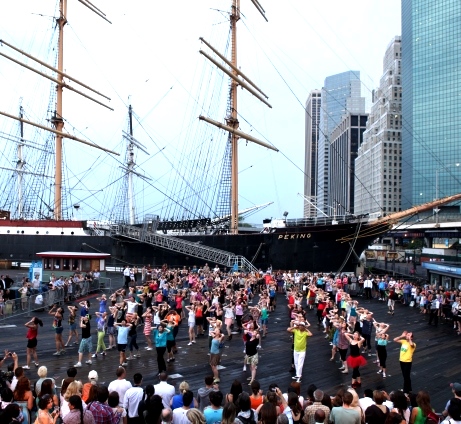Meet The Man Behind River To River 2014
We are now in the middle of the 13th annual River to River Festival, which is enlivening Lower Manhattan streets with the work and inspiration of more than 90 artists. Organized by the Lower Manhattan Cultural Council (LMCC), the series runs through June 29 and features five more days of performances, exhibitions, talks, walks, installations and more. The Alliance recently spoke to LMCC President Sam Miller about the history of the festival and what’s new this year.
Can you tell us how the River To River Festival began and how it has evolved?
River To River began in 2002 by founding partners American Express, the Port Authority of New York and New Jersey, the Alliance for Downtown New York, Arts Brookfield, Battery Park City Authority, South Street Seaport, and us (Lower Manhattan Cultural Council). Its goal was to encourage visitors, and inspire residents and workers in Lower Manhattan. Today, the festival is committed to celebrating the changing neighborhoods and built environment Downtown as a partnership between the public, private and arts sectors.
What’s new this year?
In 2014, we’re focused a lot on the social aspect of an arts festival – making sure there are opportunities for artists and audiences to mingle during the day and later in the evening at our series of “R2R Living Rooms.” We’re offering a series of participatory journeys where you are responsible for downloading an app, gathering at a meeting point and going on a “sound walk.”
How is River To River different from other arts festivals?
The surprising nature of the programming, you don’t have to reserve tickets in advance (of course many people choose to make an itinerary for themselves ahead of time, which is great too!). Also, 100% of the programming is free and much of it is outdoors.
Another interesting aspect is the diversity of events throughout the festival. There are world premieres and works-in-progress by artists who are working across all kinds of disciplines. Some pieces are for large crowds of 1,000 and others are intimate experiences for five or ten people at a time.
What do you hope spectators and participants will come away with?
We’re interested to see what audiences respond to – I hope that people are feeling adventuresome, and that they walk away from this year’s festival feeling curious to learn more about a site, artist, or art form and develop a renewed appreciation of Lower Manhattan’s distinct features.
As a location, how does Lower Manhattan itself contribute to the festival?
River To River activates the district in unexpected ways. Events take place across the entire district, south of Chambers Street, in public parks, historic landmarks, on Governors Island, and along the waterfront. Lower Manhattan is emblematic of NYC’s history and future aspirations, which are being determined now by a new residential population, a shift in local business, and the building of public and private spaces.
We know LMCC has great plans for Governors Island—can you share what’s happening?
We have been working on the island since 2010, and this past December the Trust for Governors Island awarded us the opportunity to expand our Arts Center (located in Building 110, just west of Soisson’s landing on the northern coast). This will mean more space for artists to work, and more space to share their process, and projects with the public in the gallery, at Open Studios, and public performances.
Some people may not immediately associate Lower Manhattan with culture and the arts. Why should they?
Because arts and culture are all around us! But seriously, this neighborhood also has a rich legacy of artists collaborating, sharing, living, and working. Many of the River To River artists are supported by LMCC through residency programs so they can both make and present their work downtown. This, in combination with other cultural assets in the area such as the new and old architecture, the creative technology companies who are making Downtown their home base, and the unique cuisine and retail in the area, are all what make Lower Manhattan a vibrant cultural hub.
Find out more at www.rivertorivernyc.com.



